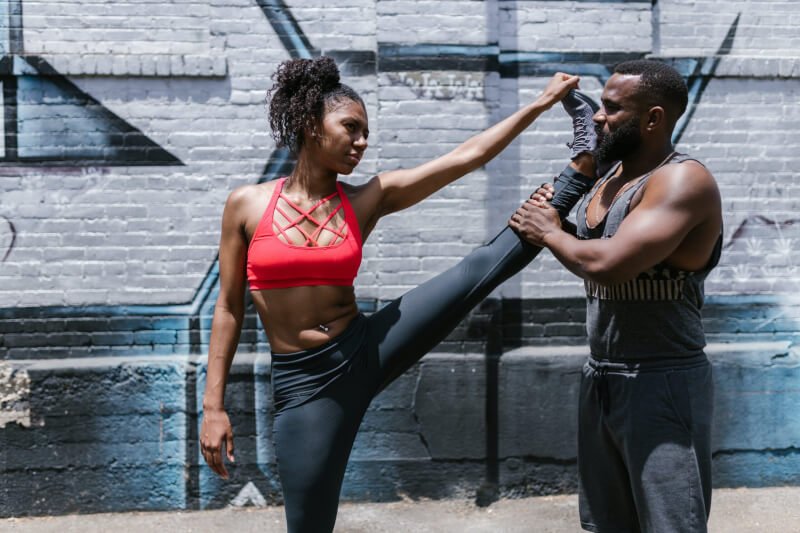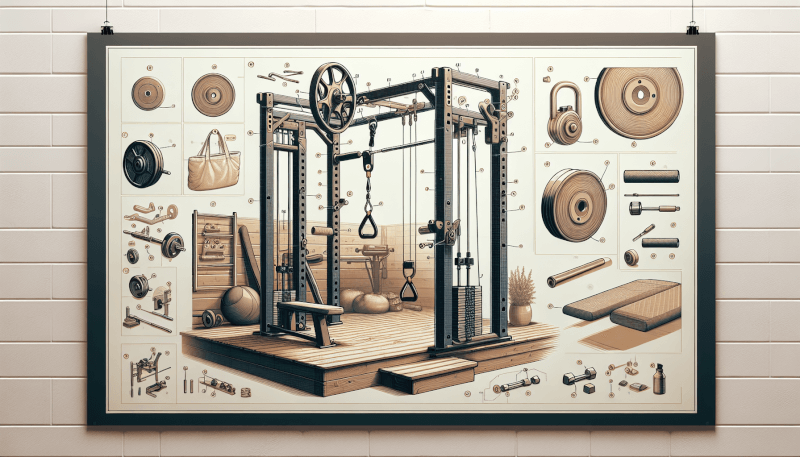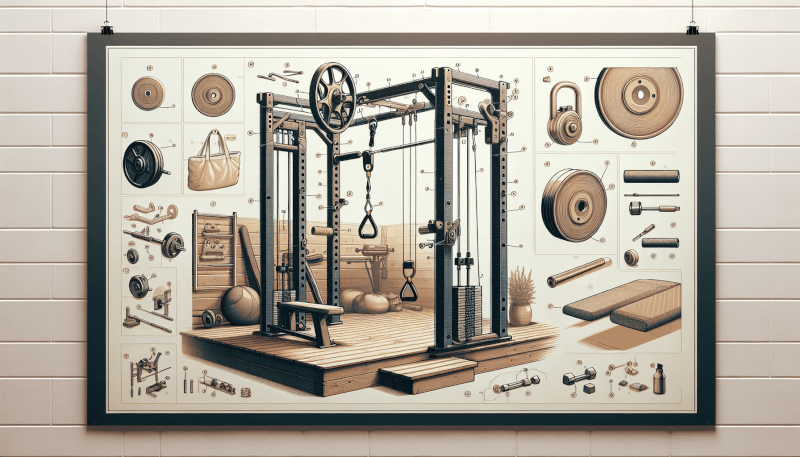Imagine having your own personal gym at home, where you can stay fit and work out at your convenience. With the “Guide to Building A DIY Home Gym Cable Pulley System” article, you will learn how to create a cost-effective and efficient pulley system for your home gym. By following the step-by-step instructions, you can easily build a cable pulley system that will allow you to perform a variety of exercises and target different muscle groups. Say goodbye to expensive gym memberships and hello to a personalized workout experience right in the comfort of your own home.
Choosing the Right Equipment
Determining your fitness goals
Before embarking on building your DIY home gym cable pulley system, it’s essential to determine your fitness goals. Are you looking to build muscle, improve your cardiovascular fitness, or enhance your overall strength and endurance? Identifying your specific objectives will help you choose the right equipment and exercises to incorporate into your workout routine.
Understanding cable pulley systems
A cable pulley system is a versatile and effective piece of equipment that enables you to perform a wide range of exercises targeting various muscle groups. It consists of cables, pulleys, and weights, and provides constant resistance throughout the movement. Cable pulley systems offer adjustable weight increments and allow for a smoother range of motion compared to traditional free weights.
Considering your available space
When designing your DIY home gym, it’s crucial to consider the available space you have. Cable pulley systems typically require more room than other types of gym equipment due to the cable length and range of motion involved in the exercises. Ensure that you have enough space for the equipment as well as comfortable movement during your workouts.
Calculating the weight capacity
Another crucial factor to consider when choosing a cable pulley system is its weight capacity. You need to determine the maximum amount of weight you will need for your workouts. Make sure to select a cable pulley system that can accommodate your current strength level and allows for progressive overload as you continue to grow stronger.
Budgeting and Planning
Setting a budget
Before purchasing any equipment, it’s essential to set a budget for your DIY home gym cable pulley system. Determine how much you are willing to invest in quality equipment that will help you achieve your fitness goals without breaking the bank. Consider the long-term benefits and durability of the equipment when setting your budget.
Researching equipment options
Once you have set a budget, take the time to research different equipment options available in the market. Read reviews, compare prices, and consider the features and functionality of each option. Look for reputable brands known for their quality and durability. Gathering all the necessary information will help you make an informed decision and get the best value for your money.
Making a list
After researching the available options, make a list of the specific equipment you need for your DIY home gym cable pulley system. Consider your fitness goals, available space, and budget while creating this list. Having a clear idea of what you need will help streamline the purchasing and assembly process.
Creating a layout
Once you have finalized your list of equipment, it’s time to create a layout for your DIY home gym. Measure the dimensions of your available space, and plan the placement of each piece of equipment. Consider factors such as ease of movement, accessibility, and safety when arranging your gym layout. A well-thought-out layout will ensure efficient workouts and maximize the space you have.

Designing Your Cable Pulley System
Selecting the anchor points
Before you start measuring and marking the locations for your cable pulley system, decide where you will anchor the cables. Depending on your available space and layout, you can choose to anchor the cables to a wall, ceiling, or dedicated support beams. Ensure that the anchor points are stable and can withstand the weight and tension of the cables.
Measuring and marking the locations
Once you have selected the anchor points, measure and mark the precise locations where the pulleys will be mounted. Take into account factors such as desired exercise range and accessibility. Use a measuring tape and level to ensure accurate placement and alignment of the pulleys.
Choosing the right cables and pulleys
When selecting cables and pulleys for your DIY home gym cable pulley system, consider the weight capacity, durability, and smoothness of the pulleys’ rotation. Opt for high-quality cables that can handle heavy loads without fraying or snapping. Choose pulleys with sealed ball bearings for a smooth and consistent movement throughout your exercises.
Determining the cable length
To determine the ideal cable length for your cable pulley system, measure the distance between the anchor points and the desired end point for each specific exercise. Ensure that the cables have enough length to provide a full range of motion without being too long or getting tangled. Take into account the height and reach of different users who will be utilizing the system.
Purchasing and Assembling the Equipment
Buying the necessary components
With your list of equipment and layout in hand, it’s time to purchase the necessary components for your DIY home gym cable pulley system. Ensure that you have all the cables, pulleys, weights, and any additional accessories needed to complete the system. Stick to your budget and prioritize quality and durability when making your purchases.
Inspecting the equipment
Once you have received all the equipment, take the time to inspect each component thoroughly. Check for any defects, loose screws, or damage during shipping. Ensure that all parts are included and in good working condition. Contact the manufacturer or seller for any missing or defective items.
Assembling the pulley system
Follow the assembly instructions provided by the manufacturer to assemble your cable pulley system. Take your time and ensure that each component is secured properly and tightened to prevent accidents during use. If you are unsure about any steps, consult the instruction manual or seek assistance from a professional.
Testing the functionality
After assembling the pulley system, conduct a functionality test to ensure that everything is working as intended. Perform various exercises with different levels of resistance and check for smooth movement, stable weight stacks, and proper cable tension. Make any necessary adjustments or fixes before proceeding with your workouts.

Safety Considerations
Finding a suitable flooring
Adequate flooring is crucial for safety and comfort during your workouts. Choose flooring that provides sufficient stability, absorbs impact, and provides a non-slip surface. Consider options such as rubber mats, interlocking foam tiles, or specialized gym flooring. A suitable flooring surface will reduce the risk of injuries due to slips, falls, or equipment shifting during workouts.
Ensuring proper cable tension
Maintaining proper cable tension is essential for the safety and effectiveness of your cable pulley system. Regularly check the tension and adjust the cables as needed. Avoid over-tightening, as it may strain the system or cause imbalances. Follow the manufacturer’s guidelines for cable tension and seek professional advice if you are unsure about the correct tension levels.
Installing safety locks
To prevent accidental weight drops or cable slippage, consider installing safety locks or stops on your cable pulley system. These locks act as a fail-safe mechanism and provide an extra layer of protection during your workouts. Make sure to position them correctly and test their functionality regularly.
Using protective equipment
When using your DIY home gym cable pulley system, it’s essential to prioritize safety by wearing appropriate protective equipment. Depending on the exercises you perform, consider using gloves, lifting straps, or knee pads to protect your hands, joints, and other body parts from potential injuries. Safety should always be a top priority when working out.
Exercises and Workouts
Choosing exercises for your goals
Now that your cable pulley system is set up, it’s time to choose exercises that align with your fitness goals. Cable pulley systems offer a wide range of exercises, including chest presses, rows, lat pulldowns, bicep curls, and leg extensions. Select exercises that target your desired muscle groups and incorporate different variations to keep your workouts challenging and engaging.
Creating a workout routine
To maximize the benefits of your DIY home gym cable pulley system, create a workout routine that includes a variety of exercises and targets different muscle groups. Design a weekly schedule that allows for rest days and gradual progression. Consider factors such as frequency, intensity, and duration when planning your workouts. Consult with a fitness professional if you need guidance in developing an effective routine.
Proper form and technique
During your cable pulley workouts, focus on maintaining proper form and technique to prevent injuries and achieve optimal results. Pay attention to your posture, breathing, and range of motion. Start with light weights and gradually increase the resistance as your strength improves. If you are unsure about the correct form, seek guidance from a qualified trainer or use instructional videos as a reference.
Progressive overload
To continuously challenge your muscles and promote ongoing growth and development, incorporate the principle of progressive overload into your cable pulley workouts. Gradually increase the resistance, repetitions, or sets of your exercises over time. This progressive approach ensures that your muscles adapt and become stronger, leading to enhanced fitness results.

Maintenance and Care
Regular cleaning
Proper maintenance and regular cleaning will prolong the lifespan of your DIY home gym cable pulley system. Wipe down the cables, pulleys, and weight stacks after each workout to remove sweat, dirt, and debris. Inspect and clean the handles and grips regularly. Use a mild disinfectant to prevent the buildup of bacteria or germs.
Inspecting cables and pulleys
Periodically inspect the cables and pulleys for signs of wear and tear. Look for frayed cables, loose connections, or damaged pulleys. Replace any worn-out parts immediately to prevent accidents or equipment failure. Lubricate the pulleys and cables as recommended by the manufacturer to maintain smooth operation.
Replacing worn parts
Over time, certain parts of your cable pulley system may wear out or require replacement. Keep track of each component’s lifespan and be prepared to replace cables, pulleys, and other parts when necessary. Following the manufacturer’s guidelines and consulting with a professional will help you determine the ideal time for replacements.
Lubricating moving components
To ensure smooth and seamless movement of the cables and pulleys, regularly lubricate the moving components of your DIY home gym cable pulley system. Use a lubricant recommended by the manufacturer and pay attention to any specific instructions regarding application. Lubrication will reduce friction, minimize wear and tear, and enhance the longevity of your equipment.
Troubleshooting Common Issues
Cable twisting or tangling
If you experience cable twisting or tangling during your workouts, check for any obstructions in the cable path. Ensure that the cables are properly aligned and that there are no knots or kinks in the line. If the issue persists, reach out to the manufacturer for further troubleshooting assistance.
Cable slipping off the pulley
If you notice the cable slipping off the pulley during exercises, verify that the pulley is correctly aligned and securely fastened. Check for any damaged or worn-out components that may be causing the slippage. Adjust the tension of the cable if needed. If the problem persists, seek professional help to prevent any potential accidents.
Uneven resistance
In case you encounter uneven resistance during your cable pulley workouts, thoroughly inspect the weight stacks and cables for any imbalances or abnormalities. Ensure that each weight plate is positioned correctly and tightened securely. If you cannot resolve the issue on your own, consider contacting a professional for a thorough inspection and adjustment.
Strange noises
If your cable pulley system produces strange noises during operation, it may indicate loose or worn-out components. Check for loose bolts, nuts, or screws and tighten them accordingly. Inspect the pulleys and cables for any signs of damage or excessive wear. Lubricate the moving parts as recommended. If the noises persist, seek professional assistance to identify and resolve the issue.

Expanding Your Cable Pulley System
Adding more pulley stations
If you find that your cable pulley system is no longer providing enough exercise variety or weight capacity, consider adding more pulley stations. This expansion will allow for a wider range of exercises and accommodate multiple users simultaneously. Ensure that your current anchor points can support the additional pulleys and adjust the cable lengths accordingly.
Increasing weight capacity
As you progress in your fitness journey and become stronger, you may need to increase the weight capacity of your cable pulley system. Verify the weight limit of your current system and consider purchasing heavier weight stacks or additional weight plates. Always follow the manufacturer’s guidelines to ensure safe and effective usage.
Incorporating additional accessories
To further enhance your workouts, consider incorporating additional accessories into your cable pulley system. Attachments such as tricep ropes, ankle straps, or a straight bar can provide new exercise variations and target specific muscle groups. Research and choose accessories that align with your fitness goals and interests.
Adjusting cable lengths
If you need to modify the cable lengths of your system due to a layout change or exercise modification, ensure that you carefully measure and cut the cables accordingly. Seek guidance from the manufacturer or a professional to ensure accurate adjustments. Always double-check the tension and alignment after making any cable length modifications.
Conclusion
Congratulations on building your DIY home gym cable pulley system! By following the steps outlined in this comprehensive guide, you have created a versatile and effective workout space that caters to your specific fitness goals and needs. Enjoy the benefits of convenience, flexibility, and privacy that a DIY home gym offers. Continue your fitness journey with dedication, proper form, and progressive overload to achieve your desired results. Remember to prioritize safety, regularly maintain and care for your equipment, and consult professionals when needed. Embrace the freedom and empowerment of having a personalized gym in the comfort of your own home. Good luck and happy training!



